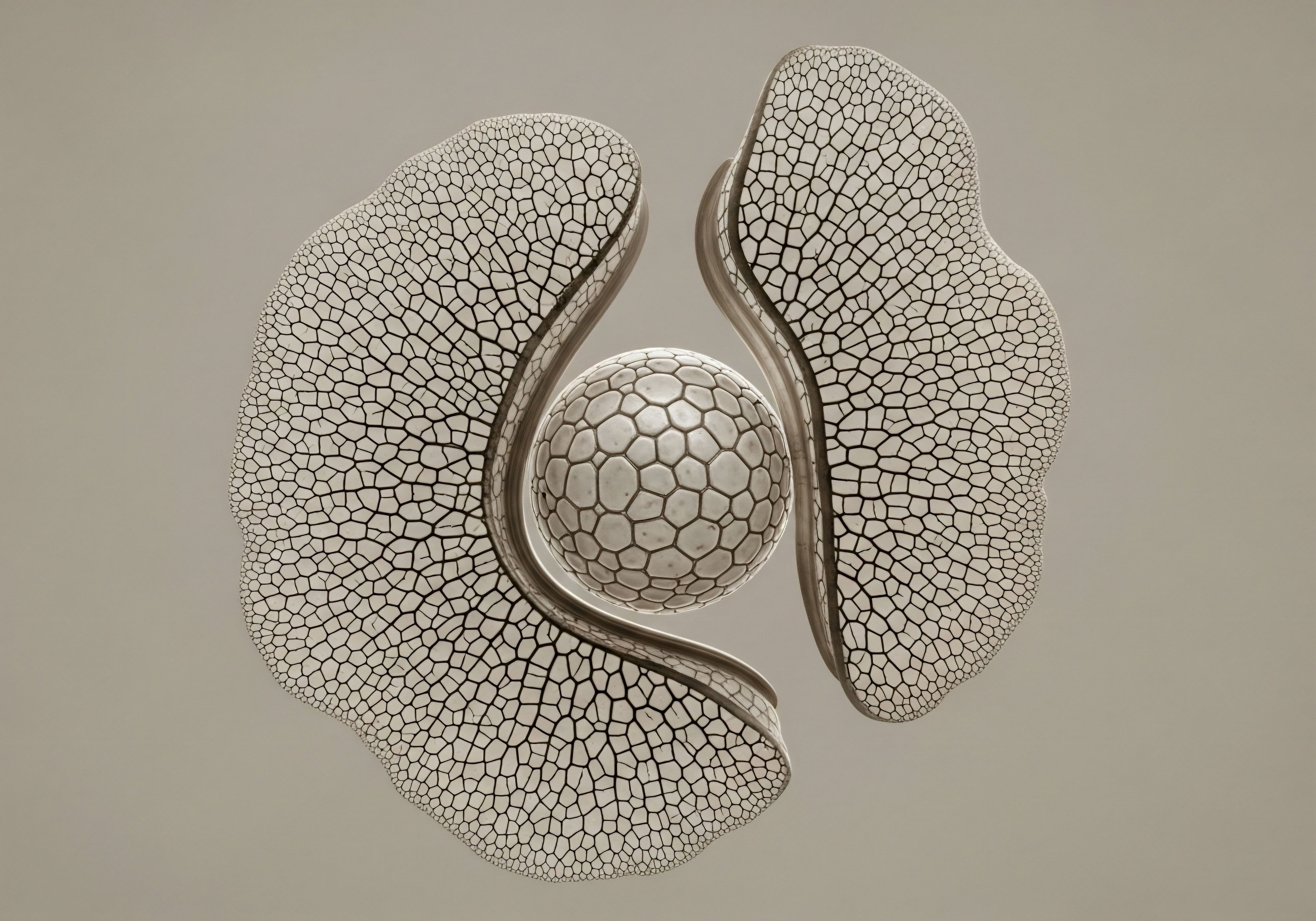

Fundamentals
You feel it in your bones, a deep exhaustion that sleep doesn’t seem to touch. The drive that powers you through board meetings and deadlines feels diminished, the mental sharpness you rely on is clouded by a persistent fog, and your carefully managed hormone replacement therapy protocol seems to be falling short.
You ask a logical question ∞ if my life demands more from me, does my body require a higher dose of hormones to keep up? The sensation is one of running a high-performance engine on a standard fuel grade; there is a fundamental mismatch between the demands placed upon the system and the resources available to meet them.
Your experience is a valid and vital data point. It points toward a profound biological reality. The architecture of your endocrine system, the intricate network of glands and hormones that governs your energy, mood, and resilience, is exquisitely sensitive to the pressures of your daily life.
To understand this connection, we must first appreciate the body as a dynamic, interconnected system. Your hormonal health is governed by a set of powerful chemical messengers, including testosterone and estrogen. These molecules are the conductors of your physiological orchestra, directing everything from cellular repair and energy metabolism to cognitive function and libido.
Hormone replacement therapy is designed to restore these conductors to their optimal levels, allowing the orchestra to play in tune. Yet, there is another major conductor that can seize the podium, especially when life becomes a relentless series of demands. This conductor is cortisol, the primary hormone of the stress response.
A demanding lifestyle creates a unique internal environment, which means your body’s hormonal needs are also unique, requiring precision over sheer quantity.
Your body’s reaction to stress is managed by a specific command-and-control pathway known as the Hypothalamic-Pituitary-Adrenal (HPA) axis. Think of it as the body’s internal emergency response system.
When you face a stressor, whether it’s a looming project deadline, a difficult negotiation, or a lack of sleep, your hypothalamus sends a signal to your pituitary gland, which in turn signals your adrenal glands to release cortisol. In short bursts, this system is brilliant.
Cortisol sharpens your focus, mobilizes energy, and prepares you to handle a challenge. The issue arises when the emergency signal never turns off. A demanding work lifestyle, characterized by long hours, high pressure, and inadequate recovery, transforms this acute response into a chronic state of high alert. Your HPA axis becomes persistently activated, bathing your entire system in a continuous flow of cortisol.
This state of sustained high cortisol has profound consequences that you are likely experiencing directly. It disrupts sleep architecture, preventing the deep, restorative rest your body needs to repair. It can interfere with neurotransmitter function, contributing to feelings of anxiety, irritability, or a flat, blunted mood.
It drives cellular processes that can lead to the very fatigue and brain fog that hinder your performance. When your body is perpetually in a state of emergency, it diverts resources away from long-term maintenance and vitality projects, like building muscle, maintaining bone density, and regulating mood, to focus solely on immediate survival.
This is the biological context in which your HRT operates. The therapy is supplying the necessary hormones, but the internal environment has been fundamentally altered by the physiological demands of your life.

The Stress Response System and Hormonal Balance
The interaction between your stress response and your hormonal balance is direct and impactful. The endocrine system operates on a principle of resource allocation and prioritization. When cortisol levels are chronically elevated, the body perceives a continuous threat that must be managed above all else.
This perception initiates a cascade of biochemical adjustments that can directly undermine the goals of your hormonal optimization protocol. Your body, in its innate wisdom, is trying to protect you from what it perceives as a hostile environment. The result, however, is a competition for resources and a disruption of the delicate signaling required for optimal function.
This internal competition is a key reason why a standard HRT dose may feel insufficient. The therapy itself is one part of a much larger, interconnected biological conversation. Understanding the influence of your lifestyle on this conversation is the first step toward recalibrating your protocol for the life you actually lead.


Intermediate
To truly grasp why your demanding lifestyle might necessitate a change in your HRT strategy, we must move from a general understanding of stress to the specific mechanical interactions between the body’s stress and reproductive hormonal systems. Your hormonal optimization protocol is designed to support a specific biological pathway ∞ the Hypothalamic-Pituitary-Gonadal (HPG) axis.
This is the central command line for your reproductive and vitality hormones. The hypothalamus produces Gonadotropin-Releasing Hormone (GnRH), which signals the pituitary to release Luteinizing Hormone (LH) and Follicle-Stimulating Hormone (FSH). These hormones, in turn, signal the gonads (testes in men, ovaries in women) to produce testosterone and estrogen. Your HRT works by supplementing this system, ensuring a consistent supply of these vital messengers.
Simultaneously, your body runs the HPA axis for stress response, as we discussed. In a state of chronic stress, these two axes are not parallel systems operating independently. They are deeply interconnected, and the HPA axis can exert a dominant, suppressive effect on the HPG axis.
Think of it as a critical national security alert overriding all regular broadcasts. The persistent signaling of the HPA axis sends a message throughout the body that long-term functions like reproduction and rebuilding are a low priority compared to immediate survival. This disruption occurs through several distinct mechanisms.

How Does the Pregnenolone Steal Pathway Affect Hormones?
One of the most direct points of conflict between the stress and sex hormone pathways is the competition for a common biochemical precursor. Your body synthesizes many of its steroid hormones, including cortisol, testosterone, and estrogen, from cholesterol through a series of enzymatic conversions.
A crucial molecule in this cascade is pregnenolone, often called the “mother hormone.” From pregnenolone, the body can produce either progesterone (which can then become cortisol) or DHEA (a precursor to testosterone and estrogen). Under normal conditions, these pathways operate in a balanced state.
In a state of chronic stress, however, the body’s demand for cortisol becomes relentless. The enzymes responsible for converting pregnenolone into the cortisol pathway are upregulated. This physiological prioritization of cortisol production effectively “steals” pregnenolone away from the pathways that lead to DHEA, testosterone, and estrogen.
Your body is shunting its raw materials toward manufacturing stress hormones at the expense of your vitality hormones. This “pregnenolone steal” phenomenon means that even with a healthy HPG axis, your body’s innate ability to produce its own androgens and estrogens is compromised. Your HRT is working to fill a reservoir that is simultaneously being drained by your body’s own stress-driven biochemistry.
Chronically high cortisol can make your body’s cells less responsive to the hormones your therapy provides, blunting the protocol’s effectiveness.

Receptor Sensitivity and Hormonal Communication
Beyond the issue of hormone production, chronic stress can also interfere with how your body listens to hormonal signals. For a hormone to exert its effect, it must bind to a specific receptor on a target cell, like a key fitting into a lock.
Chronically elevated cortisol levels can have a dampening effect on the sensitivity of these receptors, particularly for testosterone and estrogen. The hormonal “keys” are present in the bloodstream, supplied by your HRT, but the cellular “locks” become less responsive. This can lead to a state of functional hormone resistance.
Your lab results might show adequate levels of circulating hormones, yet you experience the symptoms of deficiency because the message is not being received effectively at the cellular level. This explains the frustrating disconnect between “good numbers” on a lab report and your subjective feeling of being unwell. Your protocol is delivering the mail, but the recipient is not opening it.

Developing a Personalized Protocol
This understanding leads to a clear conclusion ∞ a high-stress individual requires a more sophisticated and personalized approach to hormonal optimization. A simple increase in dosage might be a blunt instrument, potentially leading to other imbalances. The more effective strategy involves a comprehensive evaluation and a multi-pronged protocol. This begins with advanced laboratory testing that goes beyond standard testosterone and estrogen panels.
A comprehensive assessment provides a detailed map of your unique endocrine environment, allowing a clinician to craft a protocol that supports the entire system. This might involve not only adjusting your testosterone or estrogen dose but also incorporating strategies to manage cortisol, support adrenal function, and improve cellular sensitivity.
This could include nutritional interventions, targeted supplementation with adaptogens, or the use of specific peptide therapies designed to promote recovery and modulate the stress response. The goal is to create an internal environment where your HRT can work effectively.
| Biomarker Category | Standard HRT Panel | Advanced Panel For High-Stress Profile |
|---|---|---|
| Sex Hormones | Total Testosterone, Total Estrogen (Estradiol) | Total & Free Testosterone, Total & Free Estradiol, Progesterone, DHEA-S |
| Binding Proteins | Often Omitted | Sex Hormone-Binding Globulin (SHBG) |
| Pituitary Hormones | LH, FSH | LH, FSH, Prolactin |
| Stress & Adrenal Markers | Generally Not Included | Diurnal Salivary Cortisol (4-point), DHEA-S |
| Metabolic Markers | Fasting Glucose | Fasting Insulin, HbA1c, Fasting Glucose |
| Inflammatory Markers | Not Typically Included | High-Sensitivity C-Reactive Protein (hs-CRP) |


Academic
An academic exploration of your question requires us to move into the language of systems biology, viewing your physiology through the lens of allostasis and allostatic load. Allostasis is the process of achieving stability, or homeostasis, through physiological or behavioral change. It is the body’s ability to adapt to acute challenges.
Allostatic load, however, is the cumulative cost to the body of this adaptation in the face of chronic or severe stress. A demanding work lifestyle imposes a high allostatic load, which manifests as a cascade of neuroendocrine, metabolic, and immune system dysregulations that directly influence the efficacy of any exogenous hormone therapy.
The central mechanism mediating allostatic load is the sustained activation of the HPA axis and the sympathetic nervous system, resulting in chronically elevated glucocorticoids (primarily cortisol) and catecholamines. This state has profound and measurable effects on the HPG axis and on the bioavailability of the very hormones your therapy is designed to replace. To truly optimize a protocol for an individual with a high allostatic load, we must analyze these effects at a molecular level.

What Is the Clinical Significance of Sex Hormone-Binding Globulin?
One of the most clinically significant, yet often overlooked, factors in this equation is Sex Hormone-Binding Globulin (SHBG). SHBG is a glycoprotein produced predominantly by the liver that binds with high affinity to sex steroids, particularly testosterone and dihydrotestosterone (DHT), and to a lesser extent, estradiol.
When a hormone is bound to SHBG, it is biologically inactive and unavailable to bind with its cellular receptor. The physiologically active component is the “free” hormone fraction. Therefore, the concentration of SHBG in the bloodstream is a critical determinant of sex hormone bioavailability.
Chronic stress creates conditions that can significantly increase SHBG production. Elevated cortisol levels, a hallmark of high allostatic load, are associated with increased SHBG. This creates a clinical scenario where an individual’s total testosterone or total estradiol levels may appear to be within the optimal range on a standard lab test, yet they remain highly symptomatic.
The issue is one of bioavailability. The high concentration of SHBG effectively sequesters a larger portion of the circulating hormones, reducing the free, active fraction. An individual could have a robust total testosterone level, but if their SHBG is high, their free testosterone could be functionally low. Simply increasing the dose of exogenous testosterone without addressing the elevated SHBG could be inefficient, as the additional hormone may also become bound and remain inactive.
The cumulative biological wear and tear from chronic stress, known as allostatic load, fundamentally alters the neuroendocrine environment in which your HRT must operate.

Systemic Inflammation and Metabolic Dysregulation
High allostatic load is also characterized by a state of chronic, low-grade systemic inflammation. Sustained cortisol elevations can dysregulate immune function and promote the production of pro-inflammatory cytokines. This inflammatory milieu further contributes to the disruption of hormonal signaling.
Inflammation can impair the sensitivity of hormone receptors and is also linked to increased activity of the enzyme aromatase, which converts testosterone to estrogen. In men, this can lead to an unfavorable shift in the testosterone-to-estrogen ratio, contributing to symptoms like fatigue, fat accumulation, and reduced libido, even while on TRT.
Furthermore, chronic cortisol elevation is a primary driver of insulin resistance. Cortisol promotes gluconeogenesis in the liver and reduces glucose uptake in peripheral tissues, leading to higher circulating blood sugar and, consequently, higher insulin levels. Insulin resistance itself is another factor that can increase SHBG levels, creating a self-reinforcing cycle of metabolic and hormonal dysfunction.
This metabolic disruption means that any effective hormonal optimization strategy for a high-stress individual must also incorporate protocols to improve insulin sensitivity and manage inflammation.
| Factor | Effect on SHBG | Clinical Implication for HRT |
|---|---|---|
| Chronic Stress (High Cortisol) | Increases SHBG | Reduces free testosterone/estradiol, potentially blunting HRT effects. Total hormone levels can be misleading. |
| Insulin Resistance | Increases SHBG | Worsens bioavailability of sex hormones, linking metabolic health directly to HRT efficacy. |
| Thyroid Hormone (Hyperthyroidism) | Increases SHBG | Thyroid function must be optimized for proper sex hormone balance. |
| Exogenous Estrogen (Oral) | Increases SHBG | The delivery method of HRT (oral vs. transdermal/injectable) can impact SHBG and overall bioavailability. |
| Low Protein Intake | May Increase SHBG | Nutritional status is a foundational component of optimizing hormonal health. |

Advanced Therapeutic Interventions
Given this complex interplay of systems, an advanced clinical strategy is required. The answer to your question is a sophisticated recalibration of your entire protocol based on a systems-biology perspective.
- Precision Dosing ∞ HRT dosages for testosterone and/or estrogen must be titrated based on free hormone levels and the SHBG value, aiming to bring the bioavailable fraction into the optimal range.
- Adrenal and HPA Axis Support ∞ This is a direct intervention to lower allostatic load. It may involve lifestyle modifications like mindfulness practices, but also targeted use of adaptogenic herbs or even low-dose hydrocortisone in cases of demonstrated adrenal insufficiency.
- Peptide Therapy ∞ The use of growth hormone secretagogues like Sermorelin or CJC-1295/Ipamorelin can be particularly beneficial. These peptides promote the release of growth hormone, which has restorative effects on sleep quality, body composition, and tissue repair. Improved sleep is one of the most powerful ways to downregulate HPA axis activity and lower cortisol, thereby creating a more favorable environment for your sex hormones to act.
- Metabolic Optimization ∞ Protocols to improve insulin sensitivity, such as nutritional plans, exercise, and potentially metformin, are integral to managing SHBG and reducing systemic inflammation.
Your demanding lifestyle does not simply mean you need “more” HRT. It means you require a more intelligent, responsive, and holistic protocol that recognizes and addresses the systemic impact of allostatic load on your entire endocrine system.

References
- Gunnar, Megan R. and Adriana J. T. D. Quevedo. “The neurobiology of stress and development.” Annual review of psychology 58 (2007) ∞ 145-173.
- Bambino, Thomas H. and Aaron J. W. Hsueh. “Direct inhibitory effect of glucocorticoids upon testicular Leydig cell function.” Endocrinology 109.6 (1981) ∞ 2142-2148.
- Cumming, David C. et al. “The effects of acute cortisol elevations on testosterone and luteinizing hormone secretion in normal men.” The Journal of Clinical Endocrinology & Metabolism 57.3 (1983) ∞ 671-673.
- Pugeat, Michel, et al. “Sex hormone-binding globulin (SHBG) ∞ from basic research to clinical applications.” Molecular and cellular endocrinology 509 (2020) ∞ 110811.
- Rosmond, Roland, et al. “A 5-year follow-up study of the effects of the hypothalamic-pituitary-adrenal axis in obese men.” The Journal of Clinical Endocrinology & Metabolism 83.5 (1998) ∞ 1519-1523.
- Pasquali, Renato, et al. “The hypothalamic-pituitary-adrenal axis in obese women with different patterns of body fat distribution.” The Journal of Clinical Endocrinology & Metabolism 77.2 (1993) ∞ 341-346.
- Wallace, I. R. and W. S. McKinley. “Sex hormone binding globulin ∞ a review.” Annals of clinical biochemistry 28.4 (1991) ∞ 322-328.
- Kyrou, Ioannis, and Christos S. Mantzoros. “Adiponectin and bone metabolism.” Current opinion in endocrinology, diabetes, and obesity 16.3 (2009) ∞ 243-252.

Reflection
You began with a question rooted in the tangible experience of your body’s response to your life. The information presented here offers a new framework for understanding that experience, translating feelings of fatigue and diminished vitality into the precise language of biology.
It connects the pressure of a deadline to the molecular competition for pregnenolone, the exhaustion you feel to the concentration of a specific binding protein in your blood. This knowledge serves a distinct purpose. It transforms you from a passive recipient of a therapy into an informed, active participant in your own wellness protocol.
It equips you to have a more sophisticated conversation with your clinician, one that moves beyond a simple discussion of dosage to a collaborative exploration of your unique physiology.
Consider the systems within you not as failing, but as communicating. The symptoms you experience are signals, valuable data points from an intricate system responding to the environment it inhabits. Your demanding lifestyle is a powerful input into that system.
The path forward involves learning to listen to these signals with a new level of understanding and partnering with a clinical guide who can help you interpret them accurately. The ultimate goal is to craft a protocol that is not just a replacement of hormones, but a comprehensive recalibration of the entire system, allowing you to function with the vitality and resilience your life requires.
Your body has the potential to meet the demands you place on it. The key is to provide it with the precise, intelligent support it is asking for.



